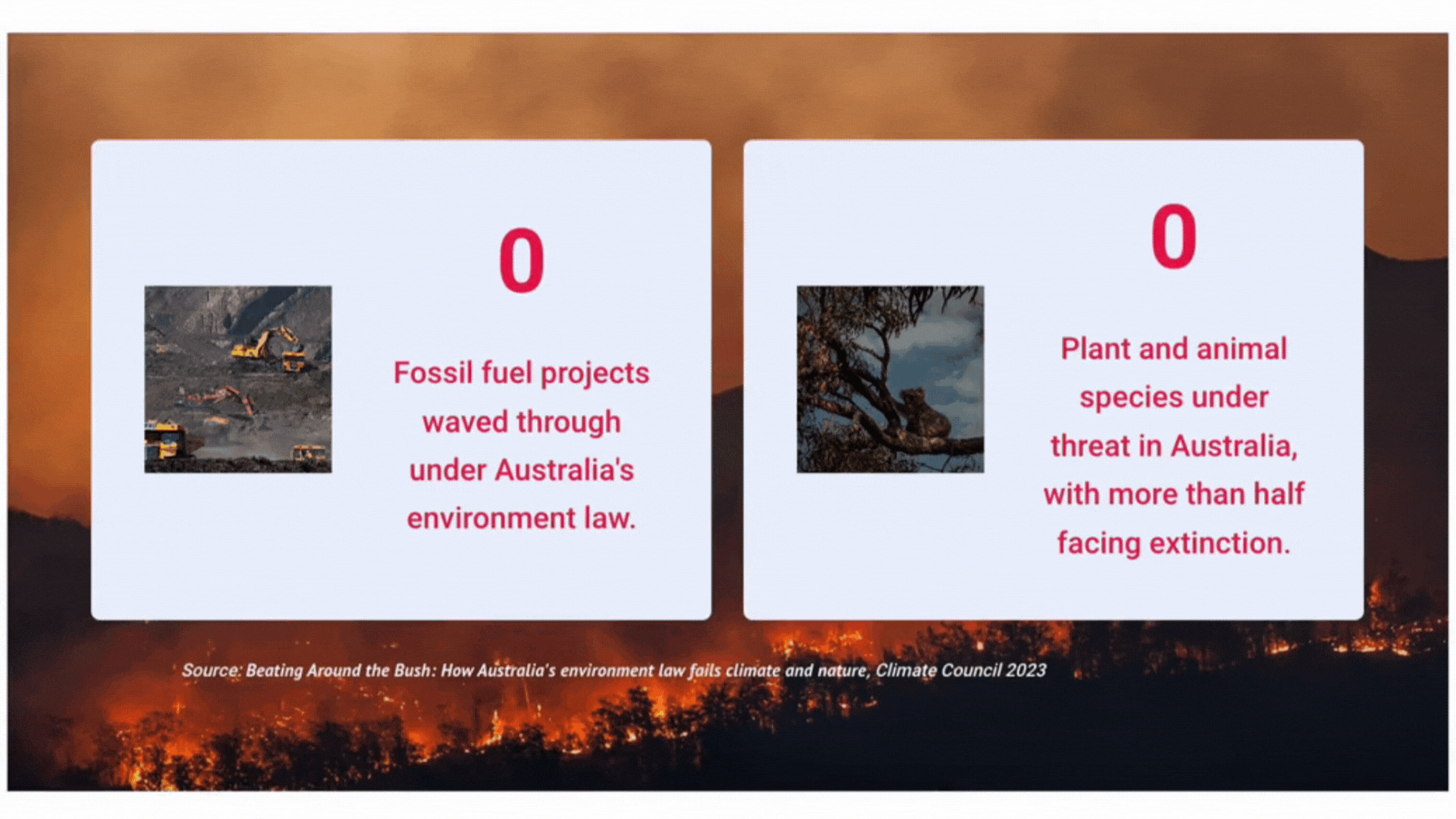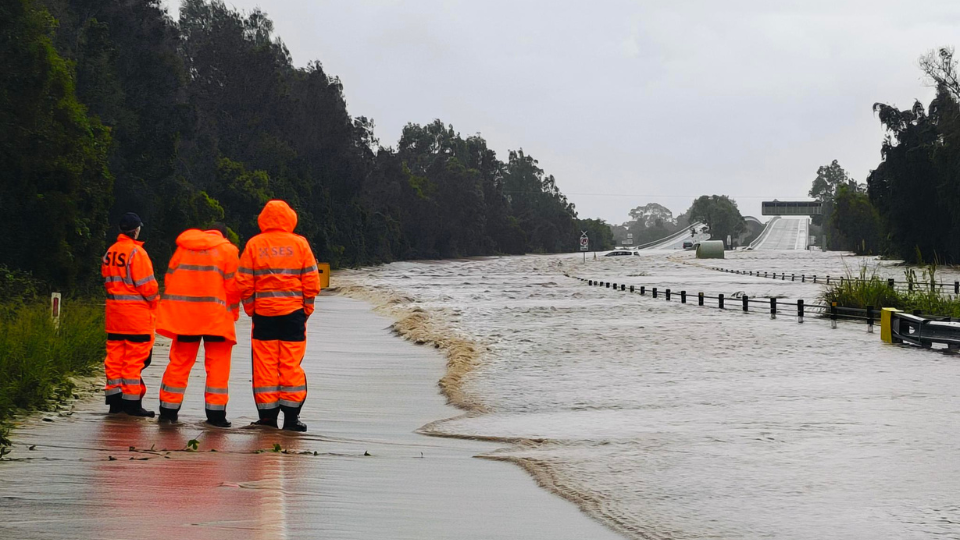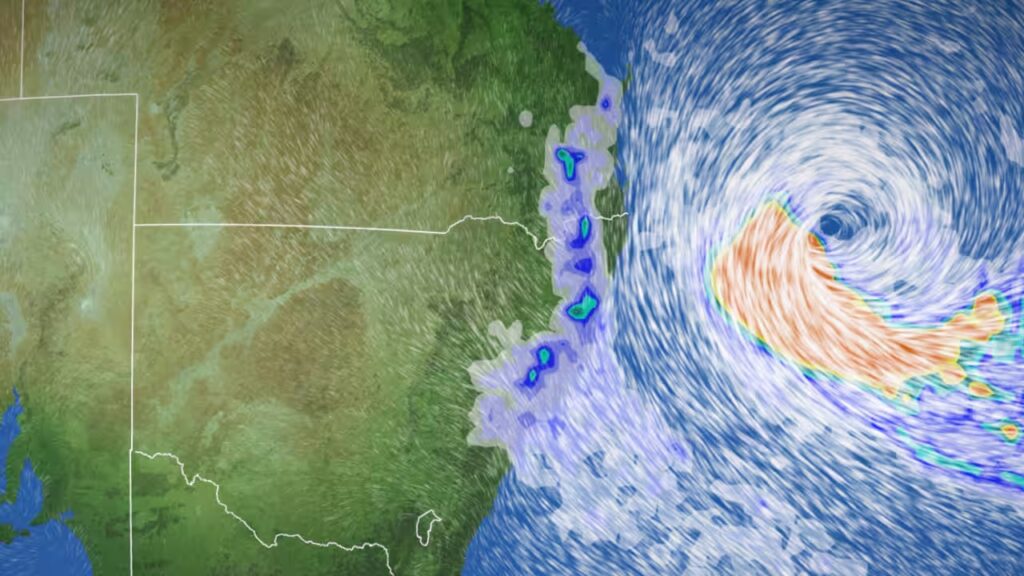Our current national environment law is fundamentally broken, because it ignores the impact of climate pollution on our precious natural environment.
But the Federal Government can fix it this year, by delivering new nature laws that actually respond to nature’s biggest threat: climate change.
These reforms are an essential step in strengthening Australia’s environmental protection efforts. They’re also a once-in-a-generation opportunity to better care for our environment as we meet Australia’s economic and energy needs, in a way that actually works for nature, communities and our climate.
It’s crucial these reforms are delivered in 2024.



Here’s the problem:
Climate pollution, caused by burning coal and gas, is driving climate change. And climate change is wreaking massive harm on our environment – from floods and fires to droughts and storms – which are increasing in frequency and severity.
But our national environment law ignores this fact, and all the climate impacts that come with pollution from digging up and burning more fossil fuels.
Back in 2020, Prof. Graeme Samuels released a damning report outlining major issues with the Environment Protection and Biodiversity Conservation (EPBC) Act. This independent, expert review found that the Act is systematically failing to protect nature. Prof. Samuels sounded the alarm that our natural environment is under extreme pressure, with urgent action needed to tackle major threats including habitat loss, invasive species, land clearing and climate change.
Right now, we have a national environment law that:
- Doesn’t mention climate change, or consider whether new projects will cause more climate harm when undertaking environmental assessments.
- Doesn’t give the decision-maker any powers to knock projects back on the basis that they will contribute to the climate crisis and cause further harm to our environment. This means new fossil fuel projects are still being waved through (740 and counting!).
- Doesn’t recognise or support responsibly delivered, clean projects to come online quickly, like the urgently-needed renewable energy and clean industry projects that will help us slash climate pollution this decade, and better protect nature.

The most recent State of the Environment report confirmed these findings, listing over 1800 plants and animals on the threatened species list, and naming climate change as the number one cause for the alarmingly poor health of our environment.
We can also see the consequences right in front of our own eyes. Climate-fuelled extreme weather is becoming more frequent and more severe, with large swathes of the country experiencing wild swings between scorching heatwaves, fires, floods, and storms. Ecosystems are on the brink of collapse, and as climate change accelerates, many threatened and critically endangered species will run out of safe, healthy places to call home.
What now?
The Government has been promising to ‘restore, manage and protect’ our natural environment with a complete overhaul of Australia’s nature law for years now, announcing its Nature Positive plan back in 2022. These were due to be introduced to Parliament by the end of 2023.
Now we are well into 2024, and Australians are still waiting to see the new legislation. An enormous amount of stakeholder time, effort, policy and legal work has been contributed towards developing these reforms, but we still don’t know where it’s all heading.
While some positive changes aimed at tackling aspects of Australia’s nature and biodiversity crisis have been announced, from what we can see, the Government’s proposed reforms don’t do anywhere near enough to fully embed climate at the heart of our national nature protection law.
We need real action to cut climate pollution, a fair and fast transition to clean energy and industry, and an end to the extinction crisis. Fixing our national environment law is core to delivering on all these promises
We need modern nature laws that embed climate, and we need them now.
Subscribe to join the Climate Council today to find out how you can help build the wave of momentum for stronger national environment law.
For information on why we collect and how we will use or disclose the personal information you have provided in this email subscription form, please see our Email Subscription Form Collection Notice here. Our Privacy Policy is also available here.
What we’re calling for:
It all boils down to this: protecting nature from climate change must be at the core of our new environment law, and embedded throughout everything it seeks to achieve.
Without this, any steps to protect our iconic natural ecosystems and wildlife will continue to be undermined by massive amounts of climate pollution from new and expanding fossil fuel projects.
We need a nature law that says NO – clearly, and unequivocally – to highly-polluting projects, such as new coal and gas, that will fuel more climate change and have unacceptable impacts on our environment.
And we need a law that can say YES – fairly, and quickly – to responsibly-delivered renewable energy, green manufacturing and critical minerals projects that are crucial to scaling up our supply of clean, reliable electricity, and cutting emissions this decade.
Here’s how the Federal Government could meaningfully update our national environment law, to better protect nature and communities from climate harm, and pave the way for a faster, fairer, and more secure energy transition:
Climate added as a ‘Matter of National Environmental Significance’
One way the Government could meaningfully update our nature law is by making climate a protected Matter of National Environmental Significance. This would pull any highly-polluting projects into the environmental assessment process, and give decision-makers a strong reason to knock back those that will cause climate harm or pose risks to our environment.
This represents one of the simplest and most straightforward ways of ensuring our nature law actually works to protect nature from worsening climate impacts. But it’s not the only way we can tackle climate change and support our energy transition with a modern nature law, and it’s critical that we embed climate into the new law as thoroughly as possible.
Some of the other top policy reforms we’re pushing for:
AN INTEGRATED APPROACH TO PROTECTING NATURE AND CLIMATE
Australia needs a holistic, integrated approach to tackling climate change, protecting nature and scaling up renewable energy. Getting our nature law right now, by making sure they complement and work with other national frameworks, will underpin the strength and speed of our energy transition and strengthen efforts to tackle the climate and biodiversity crises together.
Australia’s new national environment law should be explicitly linked to other Australian Government climate priorities and commitments, including the Paris Agreement, Safeguard Mechanism, and national Climate Change Act. Doing so would mean the new nature law is directly focused on helping to achieve Australia’s targets for cutting climate pollution, and can contribute to our efforts to hold global warming as close as possible to 1.5C. This would mean better protection of our environment from climate harm, and allow the individual project assessment process to be aligned with Australia’s long term environmental protection goals.
DISCLOSURE OF DIRECT AND DOWNSTREAM CLIMATE POLLUTION
One positive change the Government has committed to is a new requirement for developers to disclose how much climate pollution their projects directly produce. However, there is no provision that forces projects to calculate their downstream climate impact – the pollution created after their products are sold and consumed.
We know that pollution from coal, oil and gas causes climate change, no matter where in the world these fossil fuels are burned. Downstream emissions from new fossil fuel projects will drive climate change, regardless of whether Australia exports them overseas or not. In fact, it is the downstream pollution from fossil fuels produced here that has the biggest climate-wrecking impact .
Proposed projects, particularly those with high downstream emissions that will fuel more dangerous climate change, must disclose their full pollution impacts, and be accountable for this environmental harm.
MANDATORY CONSIDERATION OF CLIMATE IMPACTS IN PROJECT ASSESSMENTS
Full disclosure of direct and downstream emissions is an essential step to increasing transparency in the assessment process. But it is just as important that decision-makers actually take this information into account when assessing new projects.
Our new law must ensure the climate impacts and risks of climate pollution are among the list of factors decision-makers must consider. This would ensure that any negative or unacceptable impacts of projects are quickly identified, and positive benefits from projects that will help us slash pollution are acknowledged, and supported.
UPDATED DEFINITIONS OF IMPACTS AND ENVIRONMENT
Our existing environment law is out-of-date, and so are the definitions it uses. For example, it defines ‘environment’ in a way that doesn’t include the climate or atmosphere – the conditions that sustain all natural life on this planet. We need to bring this law into the 21st century, so that it reflects our modern understanding of climate science.
The way the law defines ‘impact’ is also crucially important. Right now, it’s too narrow to encompass the full range of climate impacts associated with new coal and gas projects, or the harm that this pollution does in fuelling climate change and damaging our environment. Updating the definition of ‘impact’ in the new law will mean decision-makers must properly consider the strong link between climate pollution and harm to nature, and use this to determine whether impacts are unacceptable or not.
Get involved:
We need a stronger nature law now, to protect our environment from the biggest threat it faces.
This is a once-in-a-generation opportunity that the Albanese Government must not miss. The Climate Council is an independent, community-funded organisation – your support makes our impact possible.










